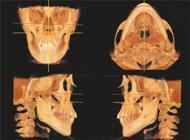OBJECTIVE:
The aim of this study is to assess dentoskeletal symmetry in cone-beam computed tomography (CBCT) scans of Brazilian individuals with Angle Class I malocclusion.
MATERIAL:
A total of 47 patients (22 females and 25 males) aged between 11 and 16 years old (14 years) seen in a private radiology service (CIRO, Goiânia, GO, Brazil) were assessed. All CBCT scans were obtained from January, 2009 to December, 2010. Cephalometric measurements were taken by multiplanar reconstruction (axial, coronal and sagittal) using Vista Dent3DPro 2.0 (Dentsply GAC, New York, USA). Minimum, maximum, mean and standard deviation values were arranged in tables, and Student t-test was used to determine statistical significance (P < 0.05).
RESULTS:
Data were homogeneous, and differences between the right and left sides were not significant.
CONCLUSIONS:
Cephalometric measurements of Brazilian individuals with Angle Class I malocclusion can be used to establish facial symmetry and three-dimensional standard references which might be useful for orthodontic and surgical planning.
Facial asymmetry; Three-dimensional imaging; Cone-beam computed tomography

 Thumbnail
Thumbnail
 Thumbnail
Thumbnail
 Thumbnail
Thumbnail
 Thumbnail
Thumbnail
 Thumbnail
Thumbnail




